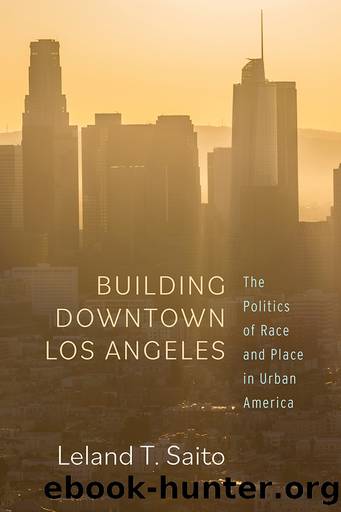Building Downtown Los Angeles by Leland T. Saito

Author:Leland T. Saito
Language: eng
Format: epub
Publisher: Stanford University Press
Published: 2022-06-15T00:00:00+00:00
Once the negotiations between the community coalition and AEG began, the coalition wanted an AEG representative present who had the authority to make decisions, rather than âa representative who had to go back and check anytime you wanted to do anythingâ (McNeill 2010). Ted Tanner, executive vice president for real estate development for AEG, who supervised the development of a number of AEG projects worldwide since joining the company in 1998, became AEGâs lead negotiator with the L.A. Live CBA. An architect, he had a deep history in development issues through his earlier work as a city planner for Philadelphia, and with the Economic Development Office for Mayor Tom Bradley from the late 1970s through the mid-1980s, a period of major growth in downtown Los Angeles.
Clearly, Tannerâs job was to represent the interests of AEG; nonetheless, coalition members developed a good working relationship with Tanner and viewed him as a sincere and thoughtful negotiator. Tanner understood through his experience working for the city of Philadelphia and discussing development projects with community organizations, that for the L.A. Live project, âour goal in continuing negotiations was to win true support and advocacy for the project,â and for the coalition, âtheir goal was the sameâto see if we could make this project better and improve benefits for the communityâ (Romney 2001a:A1).
Demonstrating the effort he put into establishing a solid rapport with the coalition, in one of the early large community meetings between AEG and the coalition, Tanner gave his presentation in Spanish. As Tanner (2017) explained, many of the residents were Spanish speakers, and although translators worked at the meetings, Tanner believed that it was important for him to try to get his information and intent delivered directly, because âthe process of translating things sometimes is awkwardâ and meaning and nuance can be lost. Tanner (2017) explained that âIâve taken Spanish in school but Iâm not fluent so I had my presentation translated for me.â Residents applauded after his presentation (Romney 2001a), recognizing his consideration and respect for the audience. Sandra McNeill (2010), a SAJE staff member, noted that while some residents had difficulty understanding Tannerâs Spanish, Tanner âhad obviously practiced really hardâ and that this effort âsaid something . . . that he felt that heâ should âstep up to enhance communication.â
Discussions between community members and developers over major projects usually take place at city-run public hearings, but in the case of L.A. Live, developer AEG and the community coalition negotiated directly, which created its own set of challenges for the coalition. Given the legal and political complexity of the entitlement process, AEG, as Haas (2002:93) noted, brought a team of âlobbyists, lawyers, and planning consultantsâ to guide the L.A. Live proposal through the process. Similarly, during the CBA negotiations, AEG and the community coalition had attorneys present so that the CBA language could be worked out at the meetings, expediting the process of formulating the final document.
The entitlement process, and negotiating, implementing, and monitoring CBAs, highlights the importance of community organizations having access to resources to effectively participate in these processes.
Download
This site does not store any files on its server. We only index and link to content provided by other sites. Please contact the content providers to delete copyright contents if any and email us, we'll remove relevant links or contents immediately.
Cecilia; Or, Memoirs of an Heiress — Volume 1 by Fanny Burney(31351)
Cecilia; Or, Memoirs of an Heiress — Volume 3 by Fanny Burney(30948)
Cecilia; Or, Memoirs of an Heiress — Volume 2 by Fanny Burney(30907)
The Great Music City by Andrea Baker(21571)
We're Going to Need More Wine by Gabrielle Union(18083)
Bombshells: Glamour Girls of a Lifetime by Sullivan Steve(13119)
Pimp by Iceberg Slim(12946)
All the Missing Girls by Megan Miranda(12774)
Fifty Shades Freed by E L James(12462)
Talking to Strangers by Malcolm Gladwell(11905)
Norse Mythology by Gaiman Neil(11901)
Crazy Rich Asians by Kevin Kwan(8369)
Mindhunter: Inside the FBI's Elite Serial Crime Unit by John E. Douglas & Mark Olshaker(7848)
The Lost Art of Listening by Michael P. Nichols(6481)
Enlightenment Now: The Case for Reason, Science, Humanism, and Progress by Steven Pinker(6414)
Bad Blood by John Carreyrou(5780)
The Four Agreements by Don Miguel Ruiz(5530)
Weapons of Math Destruction by Cathy O'Neil(5046)
We Need to Talk by Celeste Headlee(4879)
